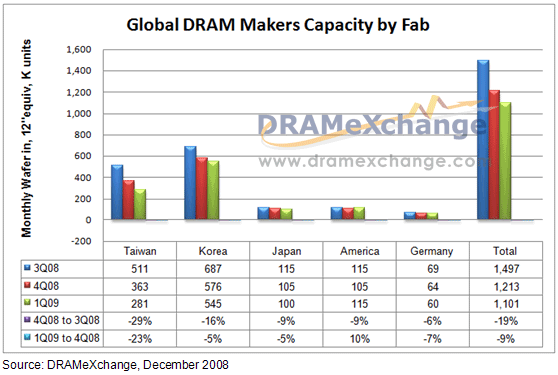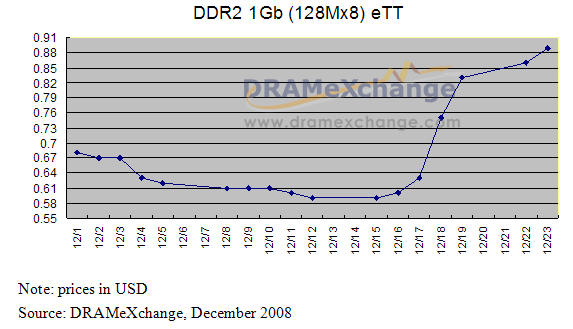

Taipei, December 23, 2008 --- After the DDR2 667Mhz 1Gb chip price plummeted through 1 USD cash cost in October and dropped to vendor’s material cost 0.6 USD, the DRAM vendors could not tolerate the loss any more and cut more and more output. According to DRAMeXchange, Taiwanese vendors cut almost 30% of their output in terms of 12” equivalent in Q4, the Korean vendor Hynix terminated its 8 inch fab output and cut 20% of its 12 inch fab output. Although Samsung hasn’t decrease its output, the total output of the Korean vendors decreased 16% in Q4. Taiwanese vendors will elongate the Chinese New Year holidays to two weeks In January 2009 hence the Q1 output will keep decreasing. According to DRAMeXchange, the output decreasing effect will last with the WW DRAM output cut in Q109. Along with the global economic downturn and the decreasing PC sales in Q109, the contract DRAM price may reach bottom but the upside momentum will be comparatively weak. On the spot price, the upside momentum is higher with the decreasing output of the major vendors and Taiwanese vendors, and may have the chance to reach 1 USD.
Figure 1: Global DRAM Makers Capacity by Fab

Last week from 16th to 22nd December (prices until today), spot chip price rallied sharply over 40% last week. DDR2 1Gb eTT chip price went up from 0.6 USD to 0.89 USD with the range of 48.3% and the DDR2 667 Mhz 1Gb chip price also increased from 0.58 USD to 0.78 USD with the range of 34.5%.
Under the financial pressure, the Taiwanese DRAM vendors were the first ones being forced to reduce output. The Taiwanese DRAM vendors are the major suppliers of the spot market, and the sales portions of spot market are as follows, PSC 90%, Promos over 50% (including sales to Kingston), and Nanya 30%. The sales portions to the spot market of the major international DRAM vendors are only 5% or lower. In Q109, the wafer input in P1, P2, P3 of PSC will keep decreasing and the output will sharply decline, but the quantity of Elpida portion, which PSC supplies to, will remain unchanged. This will decrease the PSC own portion sharply. The PSC November output was about 100M in terms of 1Gb equivalent, after deducting the Elpida portion of 40M, its own chip production was 60M. In January 2009, the output is estimated to be 70M under the output reduction effect, after deducting the 40M Elpida portion, only 30M has left for PSC which is only 50% of 60M. The output in February and March is hoped to be less than 30M in terms of 1Gb equivalent due to the wafer in reduction in December 2008 and January 2009. Meanwhile, the Promos output reduction percentage was even higher. Nanya also decreased 30% output in November (including Inotera and its own 12 inch fab). The output reduction of the Taiwanese vendors directly impacts the spot market supply. The spot price will turn the past remaining situation of over 20% lower than the contract price around in Q109. The spot price may go up 20% to 30% higher than the contract price. 1Gb eTT chip supply will sharply decrease and may drive the spot price to the range of 1 USD to 1.2 USD.
The 2H December DRAM contract price plunged over 10% under the conservative Q109 sales outlook of the PC OEMs and the low DRAM demand. The 1GB and 2GB memory module average price were about 8 USD and 16 USD. The price is close to the bottom according to DRAM vendors’ opinion, and the contract price is hoped to remain stable in Q109 and the chances of upside will depend on how the demand turns out.
The “DRAM cold front” had driven those DRAM vendors, who never wanted to give in and cut output, to decrease output as far as 50% to 70%. Some are even thinking about adopting the “build to order” strategy to avoid oversupply. After the Korean and Taiwanese government decided to support the bail out plans, the German government officially announced to support Qimonda, the German DRAM vendor. Outsiders kept questioning about that all these bail out plans will do harm to the DRAM industry recovery, but actually, these bail out plans can only provide the short term operating capital due to the limited capital amount. Eventually the DRAM vendors still have to self rescue with output cut. The global scale output cut is expected to turn the worsening DRAM oversupply situation to equilibrium and drive the current low price to surpass the vendors’ cash cost.
Before the DDR 2 price reaches the cash cost 1 USD, the DRAM vendors will keep decreasing their output.
Figure 2: DDR2 1Gb (128Mx8) eTT spot price

Subject
Related Articles
Related Reports

